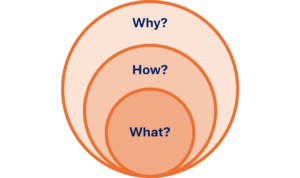
When communicating with customers, successful brands understand that focusing only on the features of their products and services isn’t enough to foster meaningful relationships. Buyers, especially B2B buyers, expect their purchase decisions to result in lasting partnerships that can sustain ongoing results. In a marketplace where competition is high and brand communications are frequent, it takes more than describing your services to entice clients. Rather, buyers want to know more about the purpose, values, and mission behind your organization.
According to Zeno Group’s “Strength of Purpose” study of 8,000 global buyers, respondents were four to six times more likely to purchase from purpose-driven companies and eventually become brand advocates. To accomplish this, prospects, customers, employees, and stakeholders need to understand the values, beliefs, and motivations behind your brand.
The Power of the “Why” Behind a Business
Communicating the purpose behind what you do might seem easy, but getting that message front and center is harder than it appears. It often takes a mindset shift from leaders and the organizational culture as a whole. Simon Sinek, a well-known speaker and author of Start with Why and The Infinite Game, is credited for the “Golden Circle” approach. The Golden Circle illustrates the three questions that can clearly articulate your company’s purpose: what do you do, how do you do it, and why do you do it?

The order in which brands address these questions to their audiences matters more than you may think. “When most organizations or people think, act, or communicate, they do so from the outside in (from what to why),” Sinek says. “We say what we do, we sometimes say how we do it, but we rarely say why we do it. But the why is the most crucial part of any endeavor or communication.”
By clearly articulating the “why” behind a business, companies can build relationships that are built to last since they are based on more than solutions. Sinek explains the core of this approach: “The goal isn’t to do business with people who need what you have; the goal is to do business with people who believe what you believe.”
Three Keys to Effectively Communicating Your Brand’s “Why”
Every brand’s audience is different, but there are a few key concepts to keep in mind, especially when it comes to communicating a company’s purpose.
1. “Why” aligns strategy with goals.
Every successful brand has a valuable service to offer, but they also have a guiding mission that keeps them focused and inspired. Communicating this within the organization means that everyone is aligned with and motivated by the same mission. A mission statement communicates the organization’s core values and purpose, defining what they do, who they serve and what they aim to achieve. A vision statement, on the other hand, is a forward-looking aspiration, illustrating where the organization aims to be in the future. Each of these is vital to defining a brand identity driven by a meaningful purpose. Communicating these foundational elements ensures everyone connected with the organization understands the “why” behind their individual role and efforts, aligning daily business activities with the overall strategy.
2. “Why” engages with the part of the brain that impacts behavior and decision-making.
Sinek explains that a particular part of the brain is activated when individuals talk about purpose and motivation. “When we communicate ‘why’ to customers, it is a way to communicate with the listener’s limbic brain,” he says. “This is the part of our anatomy that processes feelings such as trust and loyalty—as well as decision-making.” By tapping into this part of the brain, businesses can foster relationships with clients in an authentic way that connects with their beliefs and drives action. To accomplish this, an effective value proposition is a powerful tool. This short statement focuses on benefits and solutions and clearly articulates why potential customers should want to buy from you and not your competitors.
3. “Why” aligns teams with each other.
No matter the size of the business, the individuals within it are what makes the business run. Naturally, they are also people with values and beliefs. When leaders invest in understanding what makes their teams tick, they can build lasting relationships that mutually benefit the business and employees. Sinek states, “Great companies don’t hire skilled people and motivate them, they hire already motivated people and inspire them.”
Similarly, employees want to understand the mission behind the organization the contribute to. In fact, 65 percent of employees at firms with strong mission statements express a passion for their work, compared to only 32 percent at other workplaces. This figure is projected to grow with future generations of leaders and employees. For example, 84 percent of millennials prioritize finding meaning in their daily work, and 83 percent of Gen Z carefully weigh a company’s mission before applying for a job. This demands a clear mission and vision statement, but it also requires ongoing internal communications that prioritize a culture of honesty and transparency.
Commit to Answering “Why?”

A solid, well-conceived purpose that addresses the “why” of the organization will establish deep roots at all levels in the company. From entry-level employees to executives, it plays a part in corporate culture, decision-making, and client relationships. To foster authentic loyalty and engagement from clients, employees, and stakeholders, start by making sure employees understand the “why” behind what you do and how you provide solutions.

